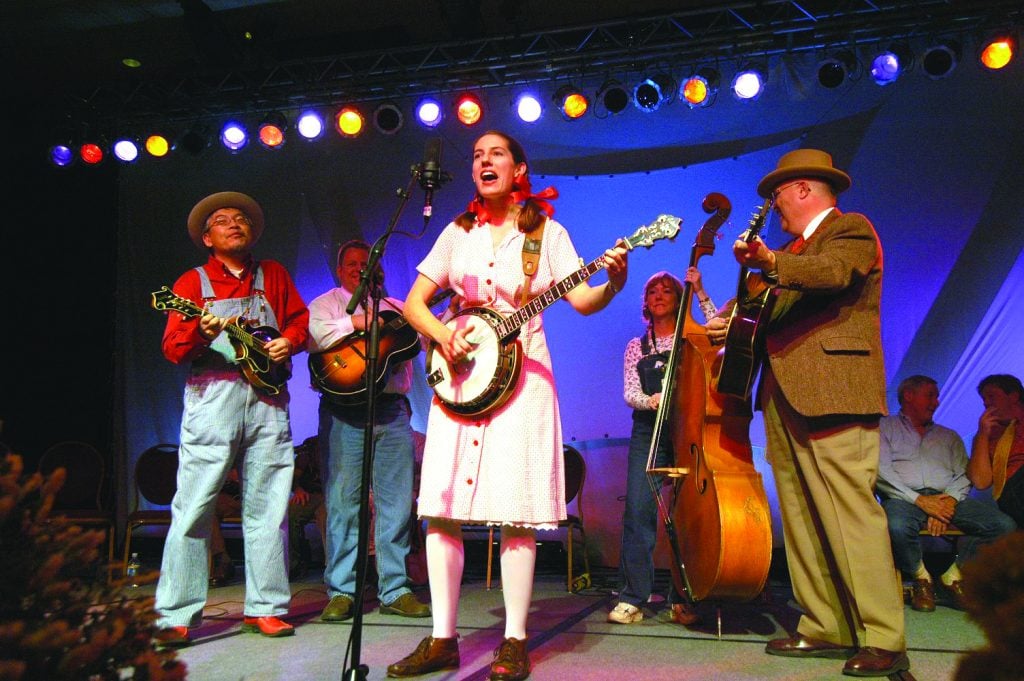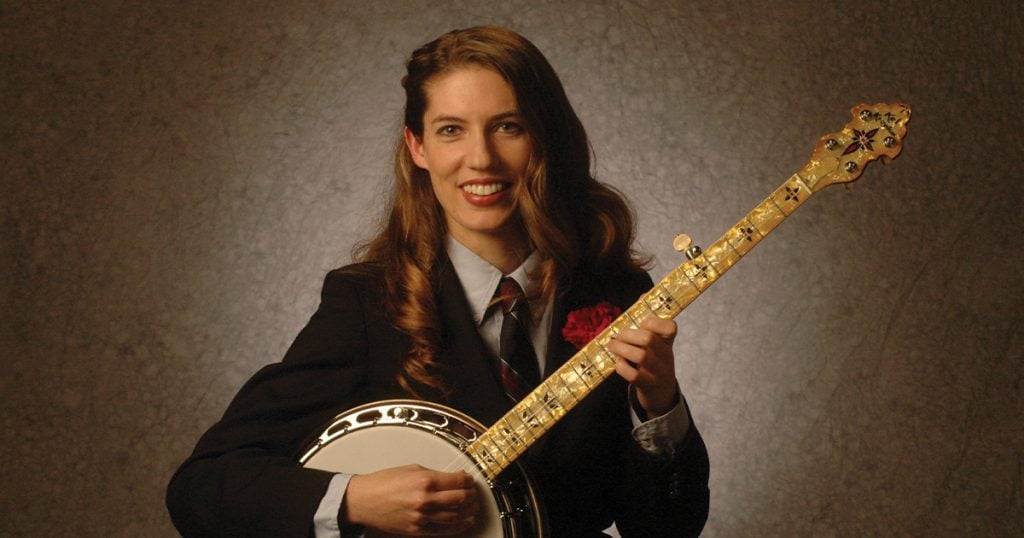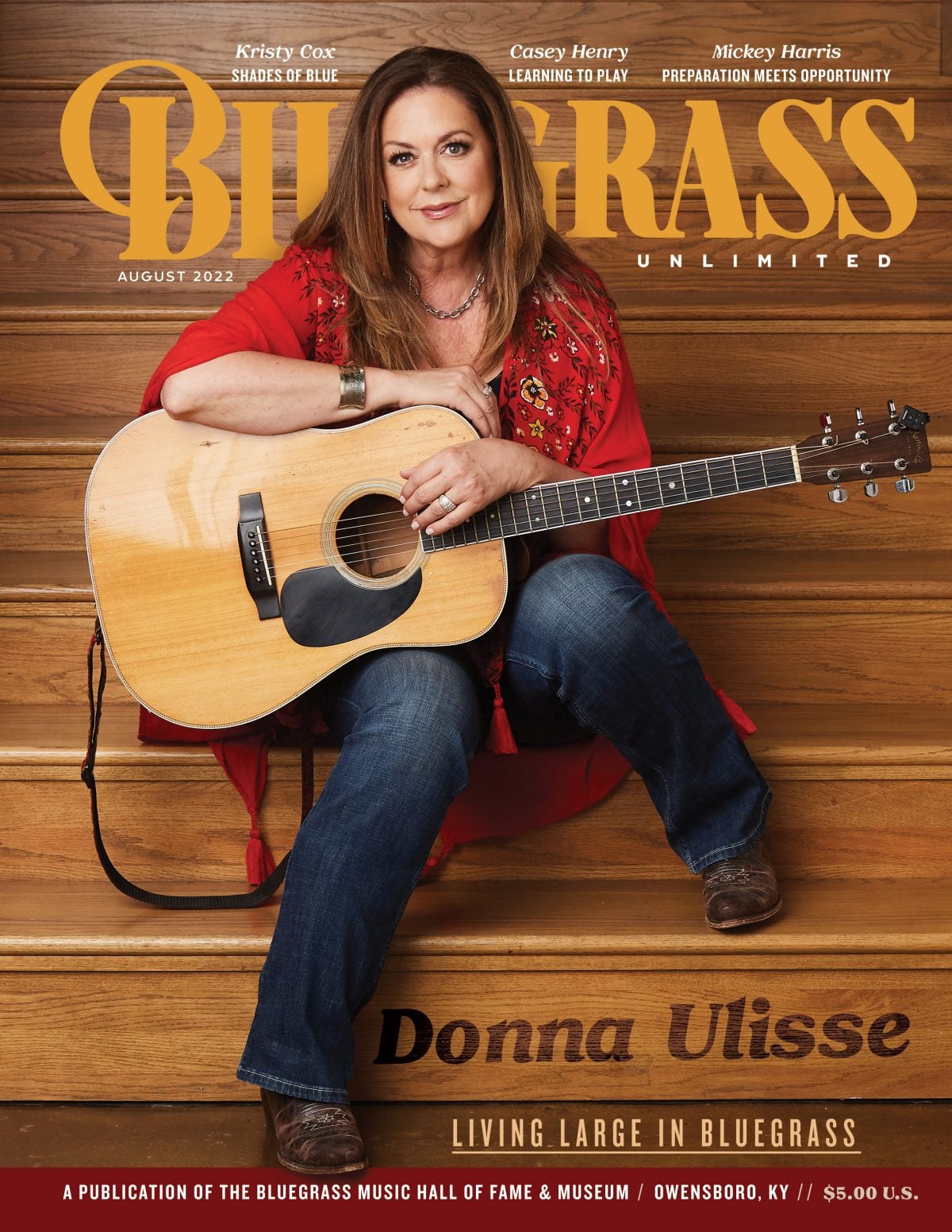Home > Articles > Learn To Play > Teaching Bluegrass is in the Family
Teaching Bluegrass is in the Family
Casey Henry was only four years old when her mother, Murphy Hicks Henry, started teaching students throughout the world how to pick the 5-string banjo via her highly acclaimed Murphy Method instructional tapes and, a year later, her articles in Banjo Newsletter. So, seeing how adept Casey is on the 5-string today, you’d think that she might have started learning how to pick the banjo before she learned how to walk…but that was not the case.
The oldest child of Red and Murphy Henry, Casey’s first instrument was the ukulele, followed by the piano and the flute. Although Red and Murphy were bluegrass musicians playing music professionally before Casey was born, they did not push either of their children into bluegrass. Casey said, “They totally let us make up our own mind. They didn’t care one way or another if we played bluegrass. They just wanted us to be happy and feel fulfilled in whatever we chose to do.”
It wasn’t until she was twelve years old that Casey became interested in playing bluegrass. She said, “I started piano lessons in the fifth grade and later played flute and piccolo in the school band. I wasn’t interested in bluegrass until my brother started playing the mandolin and guitar.” When her brother, Christopher (three years younger), started participating in their parents’ music, Casey was inspired to join in as well.
Red played the mandolin, Murphy the banjo, and Christopher the guitar. Casey decided that since no one in the family was playing bass, that would be her instrument. By the time she was fourteen the family was performing together as a band. Initially, David McLaughlin joined them on guitar until Christopher was old enough to hold down guitar duties on his own.
Although she had heard her mother play the banjo since she was born, Casey was not inspired to learn the banjo until she attended the Society for Preservation of Bluegrass Music in America (SPBGMA) convention in Nashville in 1993. She said, “I attended the SPBGMA convention with my parents to help them at the Murphy Method booth when I was fifteen. Little Roy Lewis was playing at the Stelling Banjo booth and all of these people had collected around him. He was getting a lot of attention. At that age, I wanted to get attention too and I decided that banjo was the way to go.”
When Casey returned home to Winchester, Virginia after the Nashville trip she got out her mother’s Beginning Banjo Volume One VHS tape and started learning to play by ear (the Murphy Method way). She said, “It was easy for me to pick up because I’d heard it my whole life.” The Henrys had a recording and tape duplication studio in their home and her father was in charge of making copies of Murphy’s tapes. Casey said, “Red had the lessons running over and over when he was making copies and so I had heard that for years. The music was in my head, I just had to teach my fingers how to do it.” Although she taught herself how to play from her mother’s tapes she admits that it was helpful to be able to consult her mom anytime she got stuck or needed some instruction beyond what was on the tapes.
While Casey was learning how to play the banjo, she continued to play bass in the family band. But, every set she put the bass down and picked at least one banjo tune. She said at first she performed easy tunes like “Banjo In The Hollow,” “Cripple Creek,” or “Cumberland Gap.” As her skill level progressed, the songs she performed with the band become more complex.
By the time Casey attended college at the University of Virginia, she was teaching banjo lessons to earn spending money. Murphy also hired her to help out at her music camps as an assistant instructor. She said, “Working with Murphy was helpful because I could hear how she taught and it helped me build my teaching skills.” Although work with the family band slowed down after she left for college, she did spend time performing with three other bands during her college years—Girls Night Out, DeSoto, and Grass Reflection.
After she graduated from college, Casey moved back home to Winchester and worked the same summer job she had been working for seven consecutive summers. She worked in the office of Bluegrass Unlimited Magazine. Her favorite part of the job?—picture filing. Her favorite picture find?—A photo of Carter Stanley in his coffin taken at his funeral.
The other project Casey worked on during her first year out of college was a solo instrumental album titled Real Women Drive Trucks. Helping her on this recording were Red Henry, Christopher Henry, Jason Carter, and Missy Raines—with guest appearances by Murphy Henry, David McLaughlin, and Lynn Morris. With the exception of “Liberty,” “Turkey In The Straw,” “Dixie Breakdown,” and “There’s A Little Cabin,” all of the other tracks on the thirteen track recording were original tunes.
After spending a year back at home after college, Casey was “bound and determined to become a banjo player in Nashville,” so she packed up and moved to the music city. Within one month of making the move she found a job at Cibo restaurant and another working the front desk and managing dentist Terry Comer’s office (a job she held for eleven years). She said, “That job was great because he is a bluegrass musician and he let me off work when I needed to travel and perform.”
Casey’s first music gig in Nashville was a short stint with Tim Graves. She also performed with Uncle Earl, Tennessee Heartstrings, Pat Flynn, the Jim Hurst Band, and Lizzie Long. She had an opportunity to perform with June Carter Cash, as well. Eventually she and brother Christopher formed a band called the Two-Stringers with Tyler Grant on guitar and Amanda Kowalski on bass. Before leaving Nashville she also spent two years with The Dixie Bee-Liners.
In 2011, Casey became a mother and decided to come off of the road and focus on teaching. When her first child was a little over three months old, she moved back to Winchester, Virginia and began teaching lessons out of her home.
Teaching Banjo Online
When Casey moved back home to Winchester, she had already had experience teaching private lessons, teaching at camps and teaching on video. She’d been a part of the Murphy Method videos when she first backed up Murphy on guitar and then later started teaching banjo on the videos herself. She would be called on to teach lessons relating to topics, such as melodic banjo or “fancy” Scruggs style backup, that Murphy did not want to tackle. Other videos were approached as a collaboration between mother and daughter. Casey said, “Videos like ‘Improvising in C’ we worked out together and on the video one of us would teach and the other played rhythm.”

Roughly eleven years ago, Casey also started putting videos online. The idea grew out of a request from a student who could not come to a private lesson in person and requested that Casey video tape the lesson. After making the video for that person, she realized that she could probably sell the lesson to others. She began creating custom lesson by student request and posting the full speed version, along with a complete slowed-down version, on YouTube. If someone viewed the YouTube video and wanted the complete step-by-step detailed lesson, they could order the lesson from Casey’s website. At first the full lessons were presented on a disc sent through the mail, later they became available for download through a Dropbox link as well.
After making these custom request videos for eleven years, Casey now has an enormous catalog of over 450 video lessons available for download from her website (caseyhenry.net). If you navigate to her “Lessons” page, you can view the entire list (arranged alphabetically). If you find a song you are interested in learning, you can watch a clip of Casey playing the arrangement. If you are interested in ordering the detailed lesson, you can enter the song title on a form that is provided on the lessons page, select the delivery option (Download Only, Disc Only, or Download and Disc) and place your order. The lessons cost $30 each and are taught via the Murphy Method (all by ear, no tab).
The other option that banjo students can select, instead of ordering one lesson at a time, is to join Casey’s Patreon page (follow the link on her lessons page). There are five patron levels available. The first ($1 per month) allows you to become part of the community and receive Casey’s weekly posts about new lessons and other topics of interest from her life. For this price you will also be granted access to Casey’s patron-only ordering page and receive a $10 each price on individual lessons. The second level ($3 per month) offers you all of the $1-level perks, plus access to behind-the-scenes videos. The third level ($29 per month) grants this patron all level one and two perks, plus a download link to each new lesson that Casey records that month (an average of two lessons per month). The final level ($39 per month) allows you access to every new video offered each month (via download), plus you can choose two lessons each month from Casey’s catalog. For every level there is an offer to save 16% on the price if a full year is paid in advance.
All of the material on Casey’s website is supplemental to the Murphy Method material. Casey said, “The Murphy Method videos offer a good solid learning path with a well-built method.” What Casey offers are solos to tunes, and some back up, that build on the foundation offered in the Murphy Method videos. In addition to the individual song videos, Casey also occasionally offers supplemental Zoom workshops. The content of past workshops are also available for download on Casey’s site. Topics to date have included “Fundamental Banjo Skills,” “Jam Basics,” and “Intermediate Jamming.”
Banjo Camps
In addition to the Murphy Method videos, the online individual song lesson instruction, and the Zoom classes, Casey also teaches several camps per year with Murphy. Traditionally, there has been an intermediate banjo camp, a beginners banjo camp, and a women’s banjo camp each year. The camps are held at a hotel in Winchester, Virginia. Casey said, “Murphy and I work well together and we trade off teaching. We have similar teaching styles and we feed off each other. It is a unique teaching environment with the teachers being so in sync.” There are typically twenty students at the camp. To learn more about the camps, visit www.murphymethod.com.
Private Lessons
For those students who prefer one-on-one private lessons, Casey offers lessons in person and via Skype or Facetime. When asked what common challenges most students face, Casey said, “The intermediate players tend to be weaker on back up and chord changes. I find that they forget to practice vamping. They also have difficulty playing something different from what they have memorized, or improvising. I tell them that if they are going to participate in jams, they are going to have to learn to improvise on the songs that they don’t know.”
Murphy and Casey have come up with a method to teach improvisation that they have found to be effective. First, they teach how to learn the chord changes and vamp along with those changes. Second, they teach how to roll over the changes, what they call the “roly-polys.” They feel that the forward-backward roll usually works best. From there, they teach how to upgrade the improvisation by inserting common licks and phrases that the student might know from other songs. Casey said, “When they get to that point, they can go like gangbusters.”
Murphy, Red, Casey, and Christopher Henry are all not only talented musicians, but all of them are skilled teachers. Between the Murphy Method website (murphymethod.com), Casey’s website (caseyhenry.net) and Christopher’s website—which includes guest appearances by Red (noyamountainmusic.com) you can find instruction for just about any bluegrass instrument or topic that might interest you.
Share this article
1 Comments
Leave a Comment Cancel Reply
This site uses Akismet to reduce spam. Learn how your comment data is processed.


Wondering if you do private lessons if I was ever in your area?
Private lessons online, Facebook?
I’ve learned a lot from your DVDs but really would like to improve to a more advanced level
John kearney ( Highland Ca)